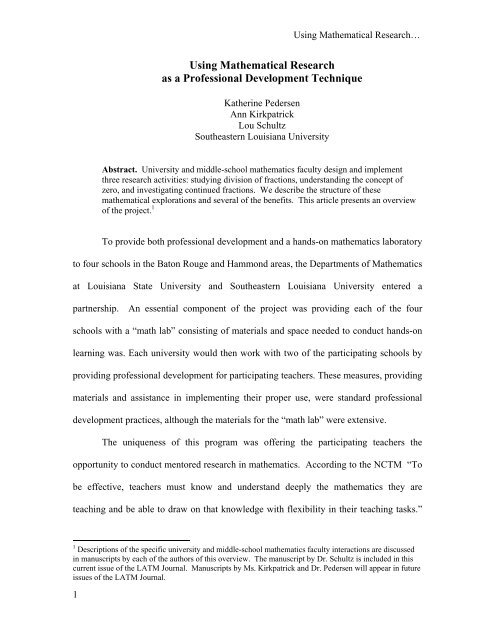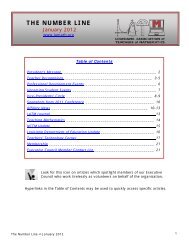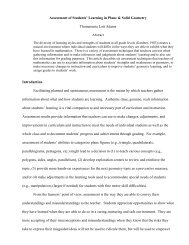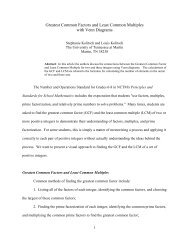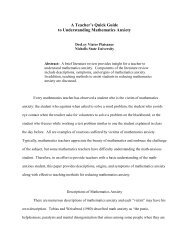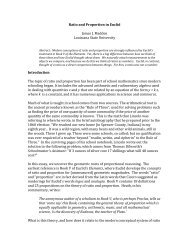Using Mathematical Research as a Professional Development ...
Using Mathematical Research as a Professional Development ...
Using Mathematical Research as a Professional Development ...
Create successful ePaper yourself
Turn your PDF publications into a flip-book with our unique Google optimized e-Paper software.
<strong>Using</strong> <strong>Mathematical</strong> <strong>Research</strong>…<br />
<strong>Using</strong> <strong>Mathematical</strong> <strong>Research</strong><br />
<strong>as</strong> a <strong>Professional</strong> <strong>Development</strong> Technique<br />
Katherine Pedersen<br />
Ann Kirkpatrick<br />
Lou Schultz<br />
Southe<strong>as</strong>tern Louisiana University<br />
Abstract. University and middle-school mathematics faculty design and implement<br />
three research activities: studying division of fractions, understanding the concept of<br />
zero, and investigating continued fractions. We describe the structure of these<br />
mathematical explorations and several of the benefits. This article presents an overview<br />
of the project. 1<br />
To provide both professional development and a hands-on mathematics laboratory<br />
to four schools in the Baton Rouge and Hammond are<strong>as</strong>, the Departments of Mathematics<br />
at Louisiana State University and Southe<strong>as</strong>tern Louisiana University entered a<br />
partnership. An essential component of the project w<strong>as</strong> providing each of the four<br />
schools with a “math lab” consisting of materials and space needed to conduct hands-on<br />
learning w<strong>as</strong>. Each university would then work with two of the participating schools by<br />
providing professional development for participating teachers. These me<strong>as</strong>ures, providing<br />
materials and <strong>as</strong>sistance in implementing their proper use, were standard professional<br />
development practices, although the materials for the “math lab” were extensive.<br />
The uniqueness of this program w<strong>as</strong> offering the participating teachers the<br />
opportunity to conduct mentored research in mathematics. According to the NCTM “To<br />
be effective, teachers must know and understand deeply the mathematics they are<br />
teaching and be able to draw on that knowledge with flexibility in their teaching t<strong>as</strong>ks.”<br />
1 Descriptions of the specific university and middle-school mathematics faculty interactions are discussed<br />
in manuscripts by each of the authors of this overview. The manuscript by Dr. Schultz is included in this<br />
current issue of the LATM Journal. Manuscripts by Ms. Kirkpatrick and Dr. Pedersen will appear in future<br />
issues of the LATM Journal.<br />
1
<strong>Using</strong> <strong>Mathematical</strong> <strong>Research</strong>…<br />
(NCTM 2000) <strong>Research</strong> supported by the Office of Educational <strong>Research</strong> and<br />
Improvement, U.S. Department of Education. on professional development stated that<br />
“<strong>Professional</strong> development should provide opportunities to engage in developing a<br />
theoretical understanding of the knowledge and skills to be learned.” (Hawley and Valli<br />
1999). A major goal of this project w<strong>as</strong> to provide the participating teachers with research<br />
b<strong>as</strong>ed experiences. The project developers felt that by participating in research, applying<br />
their new knowledge to actual lessons, and piloting these lessons with small groups of<br />
students the teachers would not only gain deeper understanding but would be able to<br />
more effectively transfer new knowledge to the cl<strong>as</strong>sroom.<br />
The concept of having in-service teachers participate in mathematics research<br />
produced some interesting questions. What type of research would be appropriate for the<br />
participating teachers How would the participants demonstrate their effectiveness in<br />
taking what they learned back to the cl<strong>as</strong>sroom How do we evaluate the overall<br />
effectiveness of this approach to professional development<br />
The summer research component w<strong>as</strong> conducted over a five week period in June<br />
and July of 2003. Louisiana State University faculty members worked with teachers from<br />
the Baton Rouge Magnet High School and Sherwood Forest Middle School. Southe<strong>as</strong>tern<br />
Louisiana University faculty members worked with participants from Hammond<br />
Westside Upper Elementary and Springfield Middle School.<br />
Dr. Katherine Pederson, Ann Kirkpatrick, and Dr. Lou Schultz of Southe<strong>as</strong>tern<br />
Louisiana University’s Department of Mathematics mentored the five teachers from<br />
Hammond Westside Upper Elementary and Springfield Middle School. All three of the<br />
faculty members had previously worked with the participating schools during early<br />
2
<strong>Using</strong> <strong>Mathematical</strong> <strong>Research</strong>…<br />
components of the “math lab” project. The first decision made w<strong>as</strong> how to separate the<br />
five participants into research groups for maximum effectiveness. This w<strong>as</strong> accomplished<br />
by taking into consideration each participant’s formal mathematical training, grade levels<br />
taught, years of experience, and cl<strong>as</strong>sroom observations by a university faculty member.<br />
The summer research component w<strong>as</strong> a five weeks program broken into two<br />
sections. During the first two week segment the participants periodically met with their<br />
mentor, decided on their research question, conducted their research, and prepared a<br />
report on their research. At the end of the first two weeks all of the participants and<br />
university faculty met at Springfield Middle School where each group presented their<br />
research and received feedback from the entire group. The second segment w<strong>as</strong> three<br />
weeks long and w<strong>as</strong> directed toward the groups refinement of their research and<br />
development of grade appropriate lesson plans. In the middle of the third week the<br />
participants and faculty members met at Sherwood Forest Middle School in Baton<br />
Rouge. Each group presented their lesson and received feedback from the other<br />
participants and university mentors. The final meeting w<strong>as</strong> held at Springfield Junior<br />
High school where the participants taught volunteer 7 th and 8 th grade students their<br />
lessons in a simulated cl<strong>as</strong>sroom setting. The students were placed in groups which<br />
rotated so that each student participated in two lessons. At the end of the day the project<br />
teachers and staff met for a final critique of the entire project from research to cl<strong>as</strong>sroom<br />
implementation.<br />
The teachers from Westside Upper Elementary and Springfield Junior High were<br />
divided into three groups for the research portion of this project. The following is a<br />
summary of each group’s progression through the six distinct parts: 1) selecting the<br />
3
<strong>Using</strong> <strong>Mathematical</strong> <strong>Research</strong>…<br />
research question, 2) researching the question, 3) analyzing the research results, 4)<br />
reporting the process and results, 5) incorporating this newly gained knowledge into an<br />
appropriate lesson, and 6) testing the lesson using students.<br />
This project surp<strong>as</strong>sed our expectations. It provided an opportunity for teachers to<br />
explore mathematical concepts in a new and rewarding manner. It showed that research is<br />
not only a means of adding to the existing knowledge pool but is also a very effective<br />
teaching tool. In depth knowledge provides a m<strong>as</strong>tery that instills confidence in the<br />
instructor.<br />
The teachers working with fractions commented on their growth <strong>as</strong> teachers and<br />
the fact that their students would benefit from their new insight. They believed that their<br />
research would enable them to add conceptual understanding to mathematical operations<br />
involving fractions. The teachers investigating zero left the program with a newly found<br />
excitement for math, learning, and teaching. Their excitement h<strong>as</strong> poured over into their<br />
teaching <strong>as</strong> evidenced by cl<strong>as</strong>sroom observations by the university faculty. They have<br />
incorporated the concepts of discovery, exploration and questioning in their teaching of<br />
mathematics and science. The teacher who investigated continuing fractions saw new<br />
connections to familiar concepts and a renewed value in different approaches to the<br />
understanding of a mathematical concept.<br />
The university mentors came away with an excitement produced by the sharing<br />
and discovery of new knowledge. As one mentor said, “This w<strong>as</strong> one of the most exciting<br />
mathematical experiences of which I have been a part of.” The collegiality created by<br />
sitting around discussing mathematics with other university faculty and the teacher<br />
participants w<strong>as</strong> a high point of the project and h<strong>as</strong> continued after the project. Another<br />
4
<strong>Using</strong> <strong>Mathematical</strong> <strong>Research</strong>…<br />
realization w<strong>as</strong> how much influence the pre-service university faculty member h<strong>as</strong> on the<br />
cl<strong>as</strong>sroom teacher years later. This influence includes but is not limited to content<br />
knowledge, pedagogy, and conceptual connections. Each of the university faculty<br />
members commented on the fact that this project h<strong>as</strong> re-energized their belief that <strong>as</strong><br />
teachers we must stress the importance of conceptual understanding and not just getting<br />
the correct answer to a problem.<br />
All of the educators involved in this project have benefited from their<br />
participation regardless of the level they teach. There is a new bond between those<br />
involved and a step h<strong>as</strong> been made toward the removal of the barrier between the various<br />
levels of mathematic instructors. One teacher who started out being intimidated by<br />
working side-by-side with a “college professor” now realizes that we only succeed by<br />
working together and that we all have something to contribute to improving mathematics<br />
education.<br />
We appreciate not only the time that the cl<strong>as</strong>sroom teachers put into making this<br />
project successful but also their willingness to share strengths and weaknesses in order to<br />
improve their teaching.<br />
References<br />
Burton, David (1998). Elementary Number Theory. New York, The McGraw-Hill<br />
Companies, Inc.<br />
Danzig, Tobi<strong>as</strong> (1954). Number: The Language of Science (Fourth Edition). New York,<br />
The Free Press.<br />
Eves, Howard (1992). An Introduction to the History of Mathematics. New York,<br />
Saunders College Publishing<br />
5
<strong>Using</strong> <strong>Mathematical</strong> <strong>Research</strong>…<br />
Hawley, Willis D. and L. Valli (1999). The Essentials of <strong>Professional</strong> <strong>Development</strong>: A<br />
New Consensus," in Teaching <strong>as</strong> the Learning Profession: Handbook of Policy<br />
and Practice. San Francisco, Jossey-B<strong>as</strong>s.<br />
Kaplan, Robert (1999). The Nothing That Is: A Natural History of Zero. New York,<br />
Oxford University Press.<br />
NCTM (1989). Historical Topics for the Mathematics Cl<strong>as</strong>sroom. Reston, National<br />
Council of Teachers of Mathematcis.<br />
NCTM (2000). Principles and Standards for School Mathematics. Reston, National<br />
Council of Teachers of Mathematics, Inc.<br />
Niven, Ivan, H. S. Zuckerman, H. L. Montgomery (1991). An Introduction to the Theory<br />
of Numbers. New York, John Wiley & Sons.<br />
Seife, Charles (2000). Zero: The Biography of a Dangerous Idea. New York, Penquin<br />
Books.<br />
Sternberg, Robert J. (1997) Thinking Styles. New York, Cambridge University Press<br />
Katherine Pedersen, Lou Schultz, and Ann Kirkpatrick are faculty members of the<br />
Department of Mathematics at Southe<strong>as</strong>tern Louisiana University. They share a common<br />
interest and expertise in working with K-12 in-service mathematics teachers.<br />
6


